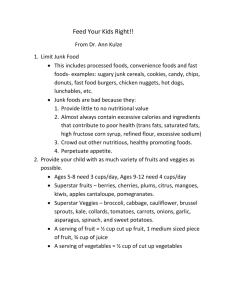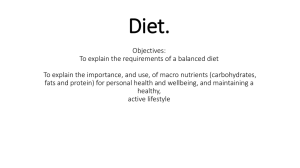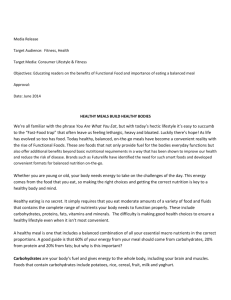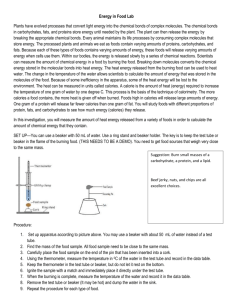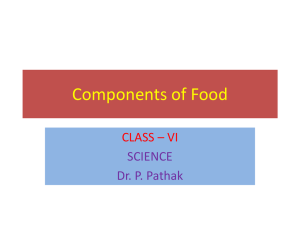Nutrition
advertisement
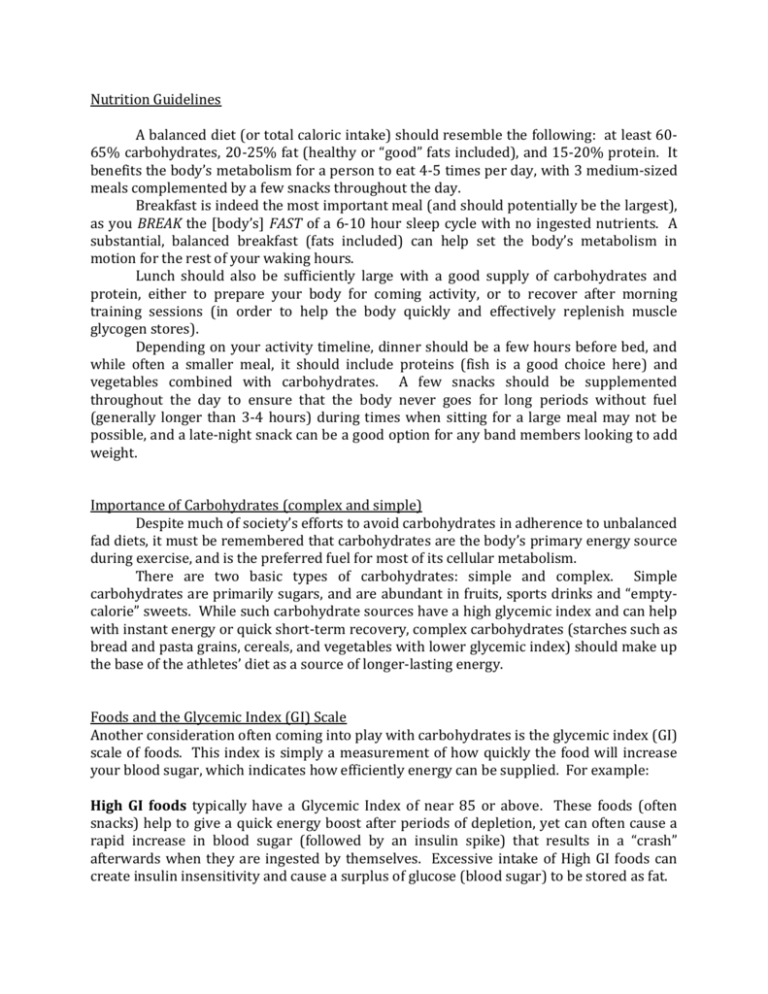
Nutrition Guidelines A balanced diet (or total caloric intake) should resemble the following: at least 6065% carbohydrates, 20-25% fat (healthy or “good” fats included), and 15-20% protein. It benefits the body’s metabolism for a person to eat 4-5 times per day, with 3 medium-sized meals complemented by a few snacks throughout the day. Breakfast is indeed the most important meal (and should potentially be the largest), as you BREAK the [body’s] FAST of a 6-10 hour sleep cycle with no ingested nutrients. A substantial, balanced breakfast (fats included) can help set the body’s metabolism in motion for the rest of your waking hours. Lunch should also be sufficiently large with a good supply of carbohydrates and protein, either to prepare your body for coming activity, or to recover after morning training sessions (in order to help the body quickly and effectively replenish muscle glycogen stores). Depending on your activity timeline, dinner should be a few hours before bed, and while often a smaller meal, it should include proteins (fish is a good choice here) and vegetables combined with carbohydrates. A few snacks should be supplemented throughout the day to ensure that the body never goes for long periods without fuel (generally longer than 3-4 hours) during times when sitting for a large meal may not be possible, and a late-night snack can be a good option for any band members looking to add weight. Importance of Carbohydrates (complex and simple) Despite much of society’s efforts to avoid carbohydrates in adherence to unbalanced fad diets, it must be remembered that carbohydrates are the body’s primary energy source during exercise, and is the preferred fuel for most of its cellular metabolism. There are two basic types of carbohydrates: simple and complex. Simple carbohydrates are primarily sugars, and are abundant in fruits, sports drinks and “emptycalorie” sweets. While such carbohydrate sources have a high glycemic index and can help with instant energy or quick short-term recovery, complex carbohydrates (starches such as bread and pasta grains, cereals, and vegetables with lower glycemic index) should make up the base of the athletes’ diet as a source of longer-lasting energy. Foods and the Glycemic Index (GI) Scale Another consideration often coming into play with carbohydrates is the glycemic index (GI) scale of foods. This index is simply a measurement of how quickly the food will increase your blood sugar, which indicates how efficiently energy can be supplied. For example: High GI foods typically have a Glycemic Index of near 85 or above. These foods (often snacks) help to give a quick energy boost after periods of depletion, yet can often cause a rapid increase in blood sugar (followed by an insulin spike) that results in a “crash” afterwards when they are ingested by themselves. Excessive intake of High GI foods can create insulin insensitivity and cause a surplus of glucose (blood sugar) to be stored as fat. Example High GI Foods: Candy, crackers, pretzels, doughnuts, raisins, carrots, potatoes, instant rice, French bread, enriched white bread, instant white rice, corn flakes, honey, syrup, sports drinks, pineapples (in syrup), cantaloupe, watermelon Moderate GI foods are wide ranging in their composition and typically hold a Glycemic Index value of between 60-85. These food sources are often a good choice for fueling the body for a period of a couple of hours and provide energy relatively quickly without dropping energy levels shortly after ingestion. Example Moderate GI Foods: Bran cereals, whole grain bread, oatmeal, shredded wheat cereal, Cream of Wheat, pasta, short-grain white rice, cous-cous, corn, Wheat Thins, bagels, graham crackers, Life cereal, blueberry muffin, banana, grapes, pineapple, orange juice Low GI foods often contain lots of fiber and exhibit the lowest Glycemic Index numbers with values below 60. These low GI foods are marked by a very slow and gradual increase in blood sugar, and therefore energy release is moderated and budgeted gradually over longer time periods throughout the day. Example Low GI Foods: Apple, peaches, pears, plums, orange, kiwi, applesauce, strawberries, blueberries, cherries, yogurt, milk, beans, brown rice, long-grain white rice, peanuts, grapefruit, tomato, broccoli Most of the best aforementioned complex-carb options (especially whole-wheat choices) are high in vitamins and generally lower in fat. Regardless, the practice of cutting carbohydrates among band members is risky and should generally be avoided, as fatigue, lack of concentration, and poor recovery will likely result. Carbohydrates can also help the body retain water in addition to keeping energy up to combat exhaustion. Many endurance athletes seeking to optimize their muscle glycogen (energy) stores will routinely “carb-load” at least 1 day prior to the competition, ensuring that at least 6570% of their total caloric intake comes from carbohydrates. “So can this practice be beneficial for marching band members?” ABSOLUTELY! Not only can carbohydrate loading help to increase (and replace) available energy stores, but carbohydrates help the body to retain water. Muscle Glycogen Repletion (following a full day of performing) Body Weight (lbs) 130 - 150 150 – 170 170 – 190 190 – 210 Post-session Carb grams 88 – 101 102 – 115 116 – 129 130 – 143 Total Daily Carb grams 360 - 420 390 - 450 420 - 490 450 – 525 Foods for Carb Loading (still be careful to limit high calorie or high-fat options) Mozzarella and American cheeses, grits, cornbread, tortilla chips, chocolate milk, quinoa, cous-cous, oatmeal, cream of wheat, fettucine alfredo, macaroni and cheese, tortellini, spaghetti, lasagna, beans and rice, peas, cheesy bean burrito, pizza, white bread rolls, hoagie rolls, tortillas, pitas, sweet potatoes, baked potatoes, mashed potatoes, stuffing, bagels, banana bread or homemade breads, muffins, Danish streudel pastries, milk, yogurt, vanilla ice cream/frozen custard, grape juice, orange juice, canned pineapples peaches (fruit cocktail), honey, Raisin Bran, Grape-Nuts, Cornflakes, low fat, high carb cheeses, raisins, dried apricots, carrots, cookies, pop-tarts, Coke. The Skinny on Fats Fats often get the bad rap because excess fat in the diet can quickly cause weight gain, and saturated or trans fats are known to cause related health problems. Indeed, total dietary fat (including healthy fats) should not make up more than 30% of total daily calories consumed. An individual seeking to lean out in a hurry can use the quick and easy “20% label” method - that is, simply place a zero behind the fat grams number on a foods label and determine if that amount exceeds 20% of its total calories. If so, the person might question if a better food alternative exists. However, there are also a variety of “good” fats that our body desperately needs for optimum functioning (most of which can be found in certain plant, nut, oil, and fish sources). Monounsaturated and polyunsaturated fats such as omega-3 and omega-6 free fatty acids (most often found in certain plants) can all help reduce “bad” cholesterol, increase vitamin absorption, and aid the body’s anti-inflammatory and cardiorespiratory processes. Most people get enough omega -6 (linoleic) fats from a standard diet, while omega –3 (linolenic ) fats are harder to come by and best obtained in the oils of fresh fish. The dietary ratio of omega -6 to omega -3 consumed should not exceed 3:1, and fish oil supplements alone are not ideal as they may contain high levels of mercury. Saturated and trans fats are strongly linked with “bad” cholesterol and heart disease. Saturated fats should make up less than 10% of your total daily intake, and has the largest effect on raising blood cholesterol (even more so than cholesterol listed on food labels, which only significantly affects 1 in 3 people). Several meat, dairy, and dessert options are often high in saturated fats, while certain fast -food items or food high in preservatives contain dangerous trans fats. When it comes to fat in the diet, moderation really is the key. Choosing lean meats (at least 95% fat-free; sometimes labeled “loin” or “round” cuts), low-fat dairy products, limiting fried or battered foods, creamy salad dressings, and gravies, and cooking with selected oils is recommended. Monounsaturated Fats Cashews, peanuts, pecans, macadamias, pistachios, almonds, walnuts, olives, avocados, olive oil, canola oil, peanut oil, sesame oil Polyunsaturated Fats Almonds, walnuts, sunflower seeds, sesame seeds, corn, soybeans, sunflower oil, corn oil, safflower oil, soybean oil, canola oil, mango fruits Omega 3’s Salmon, sardines, swordfish, trout, halibut, tuna, mackerel, herring, flaxseed, tofu, black walnuts, olive oil, canola oil, spinach, leeks Omega 6’s Cashews, peanuts, pistachios, pecans, walnuts, hazelnuts, sunflower seeds, pumpkin seeds, whole-grains, legumes, turkey, chicken , soybeans, sunflower oil, safflower oil, corn oil, avocado, flax, eggs, some mayonnaise, asparagus, mushrooms, eggplant Saturated Fats Mayonnaise, whole or 2% milk, ground beef or “ground chuck” red meats, butter, cream cheese, whipped cream, sour cream, full yogurt, granola, croissants, biscuits, pancakes, waffles, cornbread, hash browns, egg yolks, eggs benedict, pork sausage, bacon, gravy, some “candy bar-like” breakfast bars, salami, pepperoni, bologna, hot dogs, fettucine alfredo (cream sauce), lasagna, tortellini, manicotti, nacho cheese, goat cheese, blue cheese, cheddar, parmesan, Colby, Monterey Jack cheeses, coconut oil, palm oil, ranch dressing, fried or battered foods, chocolate, found in many baked goods to extend shelf life The Importance of Proteins Proteins (composed of several different amino acids) form the building blocks of an active individual’s strong and healthy body. Protein is essential to building and retaining muscle, but also to plays a huge role in transporting oxygen and producing hormones and enzymes for numerous body functions. Given a typical American diet, it should not take much effort for an to get the quantity of protein needed daily for muscle tissue repair and re-growth. High-quality Protein Sources Whey, Steak, Beef, Chicken, Roast turkey, Tuna, Fresh fish, Salmon, Pork, Veal, Milk (casein), Yogurt, Cottage cheese, Eggs, Brown/Red/refried beans, turkey/other lunch meats, peanut butter, nuts, sausage, bacon, tofu, soy Lean Protein Sources Rotisserie/grilled chicken, soy, low-fat/Greek yogurt, egg whites, shrimp, tuna, Salmon & fresh fish, loin or round cuts of beef, lean slices of smoked turkey, roast beef, ham. Turkey salami, Oatmeal, peas, hummus, baked tortilla chips, pork tenderloin, quinoa, brown rice, non-fat milk, Black/Kidney/Lima/Navy beans, skim mozzarella, low-fat cottage cheese Alcohol In addition to being a diuretic (causes the body to rid itself of needed water), alcohol is a lingering depressant that can have numerous negative effects on marching performance (ex: coordination, balance, reaction time, strength, etc.), muscle breakdown, and body temperature regulation. Alcohol is also very calorie dense at 7 calories per gram, closer on that scale to fat than is protein or carbohydrates, and may thereby serve as an accomplice to unnecessary weight gain, especially to a person trying to lean out. It is also a poor source of carbohydrates. Dietary Supplements Despite representing a multi-billion dollar sales industry, most nutritional supplements and diet pills are largely unproven (and not FDA regulated) with marginal effects. Despite their convenience and label claims, most supplements will never match the benefit of the combined nutrients that you can get from real food, which means they are less likely to be absorbed and utilized by the body. I like to think of supplements as representing the tip of the iceberg with nutrition – while they are always highly visible and advertised, it is far more important to focus on the much larger part beneath the surface (which is a standard diet comprised of a carefully balanced combination of macronutrients from natural foods). While there are some people who might benefit from multivitamin or mineral supplements because of a deficiency in their diet, if your usual daily intake incorporates a solid variety of healthy foods, you should be getting sufficient quantities of most of the needed vitamins and minerals. Also, basic multivitamin or mineral supplements do not contain fiber or sufficient qualities of antioxidants. Disordered Eating Some student-athletes may reach a dangerous level of pre-occupation with their physical appearance and how it relates to their diet or exercise habits. Because of their activity level and daily energy needs, marching band members must also be aware of these dangers. Females are more at risk to suffer from these disorders, such as anorexia nervosa or bulimia nervosa. These are damaging conditions characterized by repeated cycles of restricting intake, binging and then purging the small amounts of food eaten (anorexia); or recurrent episodes of binge eating and purging and resorting to means like laxatives, diuretics, or excessive exercise to compensate (bulimia). Some warning signs of these disorders might include a reoccurring pre-occupation with food, self-induced vomiting, failing to maintain a normal range of body weight, or the absence of at least three consecutive menstrual cycles. This latter symptom is often seen in combination with disordered eating and bone loss and commonly referred to as the “female athlete triad” – often capable of causing negative semi-permanent changes to the bodies of women who have competed in sport. Any individuals with symptoms of eating disorders should be referred to a specialist. This cannot simply be corrected by providing the afflicted person with nutritional info, as any person with an eating disorder has already become an expert about the nutritional content of food, as well as its digestion and absorption tendencies. Vitamins - These extra-important substances (vitamins A, C, D, E, K, and B vitamins) don’t contain calories, but help keep your body in a state of optimum health and performance by boosting the metabolism and immune system, functioning as antioxidants, providing energy, etc. Minerals – These substances (such as iron, zinc, calcium, magnesium, potassium, phosphorus, etc.) are micronutrients necessary to keep the body strong and to keep its various systems functioning efficiently. Super-Healthy Snacks Strawberries, Kiwi, Plums, Raisins, Almonds, Cashews Yogurt w/ blueberries, and peach, apple, or pear slices Orange Juice, Grapefruit Juice Carbohydrates Brown rice Whole wheat pastas Whole wheat pitas Whole wheat or 9-grain bread Quinoa (high in protein) Cous-Cous (also high in protein, eat in moderation) Proteins Tuna Salmon Egg whites Black beans, kidney beans Vitamins & Minerals (use olive oil or at least canola oil if cooking veggies) Broccoli, Carrots Asparagus Green peppers, red peppers Mushrooms, Green Peas Spinach Fiber Your body needs at least 25-30 grams of fiber (found primarily in whole grains and leafy greens, as well as some nuts, beans, and fruits) each day to ensure optimal function of your gastrointestinal (GI) tract. Fiber can also help lower cholesterol, control blood sugar, and promote bowel movements. Furthermore, soluble fibers can also help dietary fat pass through the gastrointestinal (GI) tract unabsorbed. Immune-boosting Foods Many of the following foods contain vitamins A,C,E as well as iron and zinc and can help to eliminate free radicals and toxins in the body (which lead to immune system breakdown.) A weakened immune system leading to bouts of sickness is a serious concern for any member of a large marching band, where members are frequently grouped together tightly and may also share instruments. While chocolate, excess sugar and fats, alcohol, lack of sleep are known to have negative effects on the immune system, there are also several foods listed below that help to increase a person’s immune response: Foods that can strengthen the immune system Lean beef Yogurt (contains probiotics) Omega -3 essential free fatty acid sources (flax, fish, almonds, olive oil) Whole Grains Orange Juice Mango Juice Strawberries, kiwi, cantaloupe, blueberries Broccoli, carrots, tomatoes Red and orange bell peppers, mushrooms, garlic Spinach Green tea (contains polyphenols) Losing weight or “leaning out” First remember that weight loss through unhealthy dieting (usually water weight) can be dangerous; the body maintains a balance for a reason. One problem with dieting (for anyone) is that it is usually a temporary solution. Many individuals who dramatically decrease their daily caloric intake will not be able to sustain this practice over the long term, especially if they are an athlete burning lots of calories on a daily basis and are therefore critically in need of energy. Furthermore, fad dieting can also ultimately cause can binge eating (due to hunger) or slow down the metabolism. Fad diets (ex: Zone, Atkins, South Beach, etc.) are founded on incomplete and temporary solutions, and often seek to reduce one of the macronutrients that athletes need most – carbohydrates. Better solutions might involve not restricting much-needed calories early in the day (ex: just subsiding on low-calorie smoothies for breakfast, or a salad for lunch) while downsizing dinner. Cutting carbohydrates and thereby losing energy is also counterproductive, as satiety signals decrease when you are tired. Don’t skip meals or snacks, just downsize them. Eat consistently throughout the day (7 days a week) at times when your body needs fuel, not out of boredom, stress, or circumstance. Scale back p.m. calorie intake, and eat breakfast. These are several factors that will help ensure an active metabolism – remember too that the body also expends extra calories just digesting food. Of course, some diet modifications may prove very beneficial. As a general rule, try not to eat two hours before bedtime. Try cutting out fast foods, soda, and empty calorie snack foods. For some athletes, reducing fat intake to 25% of total calories may be reasonable. Other steps might be to limit alcohol consumption, opt for whole grains, or regularly consume lean meats (at least 95% fat-free) grilled or baked instead of fried or battered. Don’t eat as much butter or gravy, choose red sauces instead of cream sauces, and search for low-fat dairy foods. Prepare salads with reduced-fat dressings or mayonnaise, and try to get more calories from fruits and vegetables, all the while making sure that any lower calorie foods you substitute for are just as high in nutrients. Work to exercise an hour a day (including resistance training) so that your muscles continue to store lots of glycogen for energy. Another way to seriously increase caloric expenditure is simple: RUN! Most individuals can burn around 600 calories by running for a half-hour, and people above 200 pounds can burn nearly double that! Other nutrition considerations for optimum performance Before rehearsal practices and game day performances, avoid heavy, high-fat, caloriedense, or greasy foods, high-fiber or gas-producing foods, citrus fruits, or spicy foods (remember that bread is the best way to fight the fire in your mouth if you make this mistake!) This would include: - No “heavy“ breakfast prior to morning rehearsal (greasy sausage or bacon, runny eggs, heavy gravies or syrup, hash browns); rather, low GI breakfast - No “heavy” lunch before afternoon rehearsal (within 1 HR of practice) ex. - greasy burgers, potatoes or French fries, chocolate Low Calorie Snacks Yogurt w/blueberries Strawberries, bananas, plums Apple/applesauce Peach, pear slices Cottage cheese w/pineapples Baby carrots Grapes White Tortilla chips Wheat thins Some cereals (ex. Life, Honey Bunches of Oats, Quaker Oat Squares) Sunflower seeds Pick-me-up Snacks Oranges/Orange juice Grape Juice, Pomegranate Juice, Fruit Punch Sports Drink Pineapple chunks Cantalope Watermelon Kiwi Jelly beans Candy bar Graham crackers Honey-roasted peanuts Pop-tarts Raisins Dates “YOU ARE WHAT YOU EAT!”
